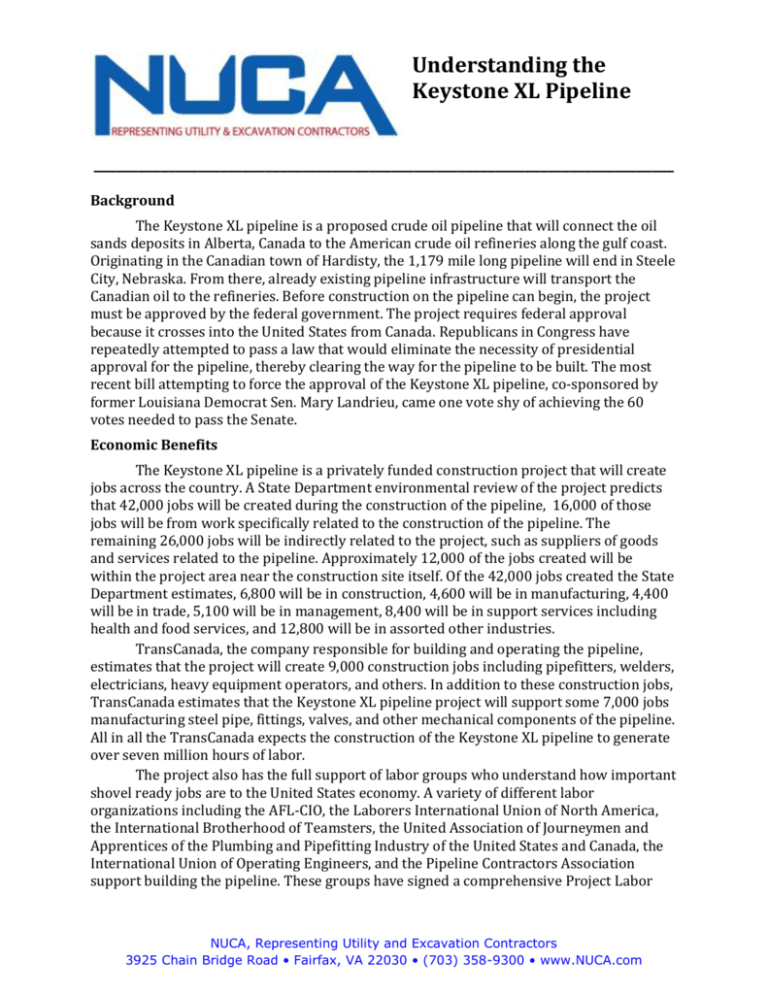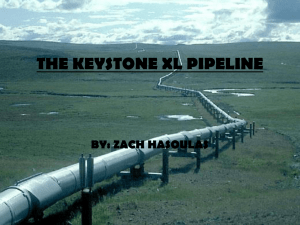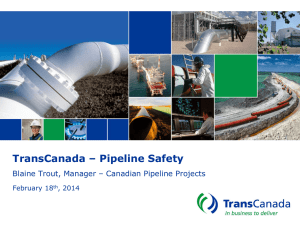The Economic benefits of the Keystone XL pipeline
advertisement

Understanding the Keystone XL Pipeline ______________________________________________________________________________ Background The Keystone XL pipeline is a proposed crude oil pipeline that will connect the oil sands deposits in Alberta, Canada to the American crude oil refineries along the gulf coast. Originating in the Canadian town of Hardisty, the 1,179 mile long pipeline will end in Steele City, Nebraska. From there, already existing pipeline infrastructure will transport the Canadian oil to the refineries. Before construction on the pipeline can begin, the project must be approved by the federal government. The project requires federal approval because it crosses into the United States from Canada. Republicans in Congress have repeatedly attempted to pass a law that would eliminate the necessity of presidential approval for the pipeline, thereby clearing the way for the pipeline to be built. The most recent bill attempting to force the approval of the Keystone XL pipeline, co-sponsored by former Louisiana Democrat Sen. Mary Landrieu, came one vote shy of achieving the 60 votes needed to pass the Senate. Economic Benefits The Keystone XL pipeline is a privately funded construction project that will create jobs across the country. A State Department environmental review of the project predicts that 42,000 jobs will be created during the construction of the pipeline, 16,000 of those jobs will be from work specifically related to the construction of the pipeline. The remaining 26,000 jobs will be indirectly related to the project, such as suppliers of goods and services related to the pipeline. Approximately 12,000 of the jobs created will be within the project area near the construction site itself. Of the 42,000 jobs created the State Department estimates, 6,800 will be in construction, 4,600 will be in manufacturing, 4,400 will be in trade, 5,100 will be in management, 8,400 will be in support services including health and food services, and 12,800 will be in assorted other industries. TransCanada, the company responsible for building and operating the pipeline, estimates that the project will create 9,000 construction jobs including pipefitters, welders, electricians, heavy equipment operators, and others. In addition to these construction jobs, TransCanada estimates that the Keystone XL pipeline project will support some 7,000 jobs manufacturing steel pipe, fittings, valves, and other mechanical components of the pipeline. All in all the TransCanada expects the construction of the Keystone XL pipeline to generate over seven million hours of labor. The project also has the full support of labor groups who understand how important shovel ready jobs are to the United States economy. A variety of different labor organizations including the AFL-CIO, the Laborers International Union of North America, the International Brotherhood of Teamsters, the United Association of Journeymen and Apprentices of the Plumbing and Pipefitting Industry of the United States and Canada, the International Union of Operating Engineers, and the Pipeline Contractors Association support building the pipeline. These groups have signed a comprehensive Project Labor NUCA, Representing Utility and Excavation Contractors 3925 Chain Bridge Road • Fairfax, VA 22030 • (703) 358-9300 • www.NUCA.com Agreement with TransCanada, which ensures that the most experienced and knowledgeable workforce possible will be assembled for the construction of the Keystone XL pipeline. Safety and Environmental Concerns Environmentalist opponents of Keystone XL have argued that it poses a danger to the surrounding environment and that the pipeline will be a significant contributor to greenhouse gas emissions, to which Keystone’s planners have been sensitive and compromising. While it is unrealistic to expect any pipeline to perform perfectly 100% of the time, the Keystone XL pipeline is designed to be one of the safest and most technologically advanced pipelines ever built. TransCanada will use satellite technology to monitor over 20,000 data points on the pipeline’s operating conditions. TransCanada has also voluntarily agreed to 57 new safety procedures to ensure greater confidence in the pipeline’s ability to safely and rapidly transport crude oil. In addition to these technological advancements, the pipeline’s route was changed in 2011 to compromise with the environmental concerns of local citizens surrounding Nebraska’s Sand Hills region. The concerns that the pipeline will significantly contribute to greenhouse gases are unfounded. The State Department’s report found that the Keystone XL pipeline will not have any measureable effect on climate change. While it does take more energy to extract and process oil sands oil into usable, transportable crude oil, this process will continue regardless of whether the Keystone XL pipeline is constructed. Additionally, if the pipeline is not built, the State Department estimates transporting the crude oil by rail or truck will increase transportation related emissions between 28-42 percent. Rail and tanker transportation also carries a higher likelihood of environment harming accidents than pipeline transport. Conclusions The Keystone XL pipeline project should be approved. The creation of 42,000 jobs, to an industry struggling to return from the economic downturn, would have a measurable impact on the economy. Polls by the Washington Post and ABC News, the Pew Research Service, and Rasmussen Reports all show that a clear majority of Americans support the construction of the Keystone XL pipeline. Credible environmental concerns have been met with compromise, diverting the planned route around an environmentally sensitive region and agreeing to additional safety and monitoring procedures. Environmentalists who argue on the grounds of increased pollution and greenhouse gasses fail to recognize that blocking the building of the Keystone XL Pipeline will not deter the refining or production of greenhouse gas emitting pollution, and will result in greater emissions as crude oil will be transported by diesel burning trains with a greater risk of environmental accident. President Obama, who has had authority to approve the Keystone XL Pipeline throughout his presidency, has avoided taking a formal position until January 2015 when he issued a veto threat to Congress. The new Senate Majority Leader Mitch McConnell announced that the “first item” on the Senate Agenda for 2015 will be a bill that authorizes TransCanada to begin construction on the pipeline. If this bill gets out of the Senate, it would easily pass the through the House and land on the President’s desk and the President should sign it into law. NUCA, Representing Utility and Excavation Contractors 3925 Chain Bridge Road • Fairfax, VA 22030 • (703) 358-9300 • www.NUCA.com






